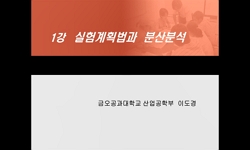Porous materials were manufactured by hydrothermal treatment of waste bottle glass without foam agent. Factorial design was applied to analyze data by statistical methods and deal with the important factors for a process. The largest effect for porosi...
http://chineseinput.net/에서 pinyin(병음)방식으로 중국어를 변환할 수 있습니다.
변환된 중국어를 복사하여 사용하시면 됩니다.
- 中文 을 입력하시려면 zhongwen을 입력하시고 space를누르시면됩니다.
- 北京 을 입력하시려면 beijing을 입력하시고 space를 누르시면 됩니다.
https://www.riss.kr/link?id=A105209276
-
저자
임동규 (경상대학교) ; 강은태 (경상대학교) ; Lim, Dong-Kyu ; Kang, Eun-Tae
- 발행기관
- 학술지명
- 권호사항
-
발행연도
2009
-
작성언어
Korean
- 주제어
-
등재정보
KCI등재,SCOPUS,SCIE
-
자료형태
학술저널
- 발행기관 URL
-
수록면
275-281(7쪽)
-
KCI 피인용횟수
4
- 제공처
-
0
상세조회 -
0
다운로드
부가정보
다국어 초록 (Multilingual Abstract)
Porous materials were manufactured by hydrothermal treatment of waste bottle glass without foam agent. Factorial design was applied to analyze data by statistical methods and deal with the important factors for a process. The largest effect for porosity was for temperature of hydrothermal treatment. Amount of water and temperature-water interaction appeared to have little effect. The particle size of raw material was also identified as a major factor by one-way ANOVA and the porosity decreased as the size increased. The sintering temperature was not statistically significant for the porosity but was significant for the pore size. The porous material had compressive strength and thermal conductivity comparing with those of ALC (autoclaved lightweight concrete), although it has higher porosity than for ALC.
참고문헌 (Reference)
1 E. N. Boulos, "Water in Glass : A Reiew" 41 : 83-90, 1970
2 M. Tomozawa, "Water in Glass" 73 : 197-204, 1985
3 F. A. Sigoli, "Porous Silica Matrix Obtained from Pyrex Glass by Hydrothermal Treatment: Characterization and Nature of the Porosity" 86 (86): 1196-1201, 2003
4 F. M. Ernsberger, "Molecular Water in Glass" 60 (60): 91-92, 1977
5 "Korea Glass Industry Cooperative"
6 T. Uchino, "Interpretation of Hydrated States of Sodium Silicate Glasses by Infrared and Raman Analysis" 74 (74): 306-313, 1991
7 R. F. Bartholomew, "Infrared Spectra of a Water-Containing Glass" 63 (63): 481-485, 1980
8 D. P. Zaburin, "Infrared Spectra of Hydrogen Bonded Hydroxyl Groups in Silicate Glasses. A Re-interpretation" 40 (40): 184-192, 1999
9 D. M. Liu, "Influence of Porosity and Pore Size on the Compressive Strength of Porous Hydroxyapatite Ceramic" 23 (23): 135-139, 1997
10 H. Scholze, "Incorporation of Water in Glasses : I" 32 : 81-88, 1959
1 E. N. Boulos, "Water in Glass : A Reiew" 41 : 83-90, 1970
2 M. Tomozawa, "Water in Glass" 73 : 197-204, 1985
3 F. A. Sigoli, "Porous Silica Matrix Obtained from Pyrex Glass by Hydrothermal Treatment: Characterization and Nature of the Porosity" 86 (86): 1196-1201, 2003
4 F. M. Ernsberger, "Molecular Water in Glass" 60 (60): 91-92, 1977
5 "Korea Glass Industry Cooperative"
6 T. Uchino, "Interpretation of Hydrated States of Sodium Silicate Glasses by Infrared and Raman Analysis" 74 (74): 306-313, 1991
7 R. F. Bartholomew, "Infrared Spectra of a Water-Containing Glass" 63 (63): 481-485, 1980
8 D. P. Zaburin, "Infrared Spectra of Hydrogen Bonded Hydroxyl Groups in Silicate Glasses. A Re-interpretation" 40 (40): 184-192, 1999
9 D. M. Liu, "Influence of Porosity and Pore Size on the Compressive Strength of Porous Hydroxyapatite Ceramic" 23 (23): 135-139, 1997
10 H. Scholze, "Incorporation of Water in Glasses : I" 32 : 81-88, 1959
11 G. W. Morey, "High SiO2 Corner of System Na2O-CaO-SiO2" 9 : 232-233, 1925
12 G. Buntebarth, "Experimental and Theoretical Investigations on the Influence of Fluids, Solids and Interactions Between them on Thermal Properties of Porous Rocks" 23 : 1411-1146, 1997
13 R. F. Powell, "A Realistic Approach to Laboratory Thermal Conductivity Experiments with Solids" 4 : 199-203, 1969
동일학술지(권/호) 다른 논문
-
- 한국세라믹학회
- Oh, Won-Chun
- 2009
- KCI등재,SCOPUS,SCIE
-
나노 적층 구조를 응용한 저항성 기반 비휘발성 메모리 소자 특성 제어
- 한국세라믹학회
- 유일환
- 2009
- KCI등재,SCOPUS,SCIE
-
Sm을 첨가한 BaTiO3계의 재산화 온도 및 시간에 따른 PTC 특성 변화
- 한국세라믹학회
- 정용근
- 2009
- KCI등재,SCOPUS,SCIE
-
LTCC 기판재료 응용을 위한 다양한 충전제 함유 CaO-Al2O3-SiO2 유리복합체 연구
- 한국세라믹학회
- 김관수
- 2009
- KCI등재,SCOPUS,SCIE
분석정보
인용정보 인용지수 설명보기
학술지 이력
| 연월일 | 이력구분 | 이력상세 | 등재구분 |
|---|---|---|---|
| 2023 | 평가예정 | 해외DB학술지평가 신청대상 (해외등재 학술지 평가) | |
| 2020-01-01 | 평가 | 등재학술지 유지 (해외등재 학술지 평가) |  |
| 2010-01-01 | 평가 | 등재학술지 유지 (등재유지) |  |
| 2008-01-01 | 평가 | 등재학술지 유지 (등재유지) |  |
| 2006-01-01 | 평가 | 등재학술지 유지 (등재유지) |  |
| 2004-01-01 | 평가 | 등재학술지 유지 (등재유지) |  |
| 2001-01-01 | 평가 | 등재학술지 선정 (등재후보2차) |  |
| 1998-07-01 | 평가 | 등재후보학술지 선정 (신규평가) |  |
학술지 인용정보
| 기준연도 | WOS-KCI 통합IF(2년) | KCIF(2년) | KCIF(3년) |
|---|---|---|---|
| 2016 | 0.16 | 0.16 | 0.17 |
| KCIF(4년) | KCIF(5년) | 중심성지수(3년) | 즉시성지수 |
| 0.16 | 0.16 | 0.331 | 0.06 |






 ScienceON
ScienceON


